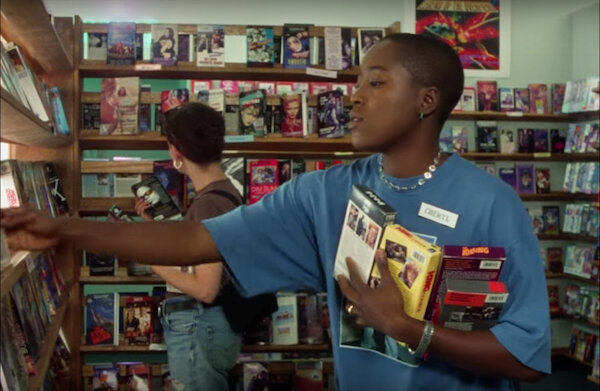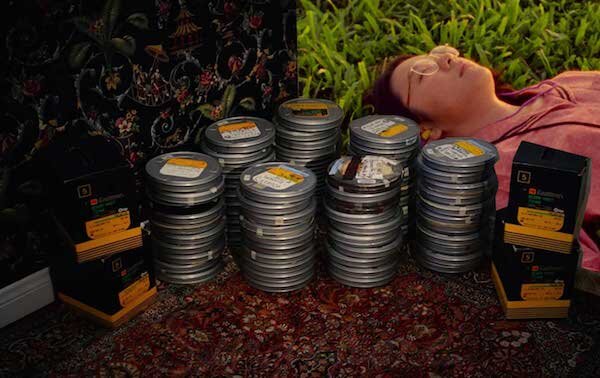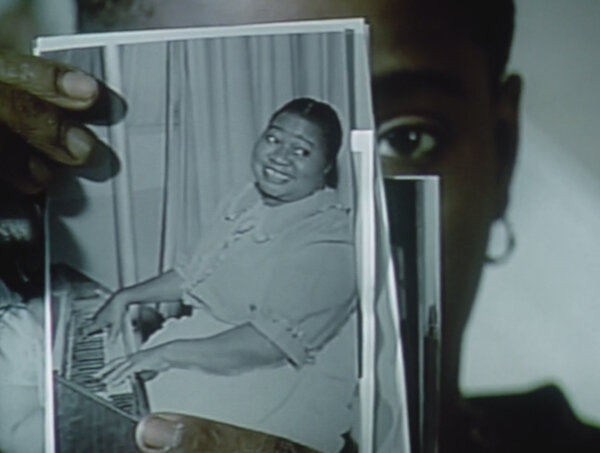Cheryl Dunye is the first black lesbian filmmaker, and Sandi Tan rewrote the rules for domestic filmmaking in Singapore. Both women explored forgotten histories, and painstakingly worked to give themselves, and an entire generation, a new future. Emily Garbutt writes on the game-changing power of The Watermelon Woman and Shirkers.
“What is history? Who makes history, and who’s left out?” filmmaker Barbara Hammer asked in an interview with BOMB Magazine in 2018. In The Watermelon Woman and Shirkers, directors Cheryl Dunye and Sandi Tan endeavour to answer these same questions. They attempt to reclaim history – their own, or a shared cultural history – from a patriarchal thief through the act of documentary-making, whether that’s fictional or factual. The threat of white patriarchy is present at a systematic level in The Watermelon Woman, and at a personal level in Shirkers.
In The Watermelon Woman, Cheryl (played by Dunye) endeavours to uncover the identity and history of the titular character, a black actor who had roles in 1930s Hollywood movies but isn’t credited for her work. Meanwhile, in Shirkers, Sandi Tan seeks to reclaim lost footage from a film she and her friends made as teenagers, also named Shirkers. The film reels were stolen by their charismatic older mentor after production wrapped. For both of these women, film, and specifically documentary, is used as a medium to document their present while simultaneously reclaiming their past.
Released in 1996, The Watermelon Woman was the first feature film directed by a black lesbian woman. Its protagonist, Cheryl, works in a Philadelphia video rental store, but in her spare time she’s making a film. We soon become acquainted with the project, aimed at uncovering the identity of the so-called ‘Watermelon Woman’. In her first address to camera, Cheryl explains that for as long as she’s wanted to make a film, she’s known it had to be about black women “because our stories have never been told.”
Meanwhile, Shirkers begins by introducing us to the director as she came of age in Singapore during the late 1980s. What is a shirker? Tan is a shirker, and so are her friends. A shirker refuses to play by the rules, to sit inside the existing boundaries for someone of their age and gender. As teenagers, Tan describes how she and her friend Jasmine Ng “devoured what others around us ignored”: they made zines, watched David Lynch films and listened to Patti Smith. However, alternative culture in 90s Singapore was a boys’ club – Tan and Ng didn’t fit in, and didn’t want to, either.
We learn how the original Shirkers was made with the help of Ng, their friend Sophia Siddique Harvey and their film teacher Georges Cardona in the summer of 1992 – and then how it all fell apart. After filming was completed, Tan, Ng and Siddique Harvey returned to the UK and the US for their second year of university, leaving the film in Cardona’s hands. They never heard from him again.
There was little domestic filmmaking in Singapore in the early 1990s. Siddique Harvey tells us: “Shirkers is like the ghost in between the lines of books written on Singapore film history… [it] has a very palpable absence.” The documentary attempts to fill in these gaps in the country’s film history; through it, Tan enables a debut feature named Shirkers to exist. She takes back what was stolen from her and her friends, and establishes a place for young women in Singaporean film history.
In The Watermelon Woman, Cheryl doesn’t have much luck with formal methods of historical research – her trips to libraries, archives, and to speak to academics don’t yield anything particularly useful, exemplifying further gatekeeping from a history written by a white patriarchal society. Her most successful research technique turns out to be simply having conversations with other black women – through one such conversation, she discovers that the Watermelon Woman’s real name was Fae Richards.
Another woman Cheryl manages to make contact with is June Walker, who was Fae’s partner before she died. In a letter to Cheryl, June says, “She paved the way for kids like you to run around making movies about the past and how we lived then. Please, Cheryl, make our history before we are all dead and gone.”
Cheryl speaks to the camera as she replies to June, “What she means to me, a 25-year-old black woman, is something different. It means hope, it means inspiration, it means possibility. It means history.” For Cheryl, Fae emphasises what any marginalised community already knows: history is manufactured by those in power. For those groups to see themselves in history, they must seek it out and write it down themselves.
Meanwhile, Tan’s breakthrough came in 2011, when she received an email from Cardona’s wife with the news of his death. She had found 70 cans of film in perfect condition, all labelled “Shirkers”. We follow Tan as she visits Cardona’s widow in the US, who “remains so horrified by her 25 years with Georges that she didn’t want to be named.” Tan learns what happened to her film and attempts to reclaim her past from Cardona; “I felt as if a curse, which lasted 20 years, had finally been lifted,” she says.
Cardona had kept not just the film but also the scripts, storyboards, and other production paraphernalia. He’d taken the boxes filled with these mementos with him from Singapore when he moved to Australia, then onto the US. However, although he had kept the film in perfect condition, he’d thrown away all the sound recordings: “Shirkers was returned to us a mute,” says Tan. If it wasn’t factual, you might think the metaphor a little on the nose – Cardona robbed Tan of her voice.
There is no cure to the grief Tan feels for the original Shirkers; the documentary does not return all that was lost. But its creation was therapeutic: “Making this film, I’ve come to realise that Georges’ ghost will never truly leave me,” Tan says. “And I’ve learned to think: ‘That’s okay.’”
After Cheryl’s heartfelt speech, The Watermelon Woman ends on a somewhat bittersweet note. Text fills the screen: “Sometimes you have to create your own history. The Watermelon Woman is fiction.” The postscript is stark and melancholy – we have become invested in Fae’s life, who we’re then told doesn’t exist. Ultimately, it serves as a damning insight into reality – the implication being that if there is a real-life equivalent of the Watermelon Woman, she has already been lost to the past.
The ending of Shirkers is also bittersweet. Tan visits her friend Ben Harrison, who plays her the music he originally wrote for the soundtrack 25 years ago – Cardona took the only copy of the tape he made as a teenager and forbade him from visiting the set – and a montage of footage from the film plays. In Tan’s direction, the grief for what has been lost is evident, and so is the love she clearly still has for the film.
In The Watermelon Woman and Shirkers, Dunye and Tan use documentaries to take history into their own hands. Dunye does for a future generation of black lesbian filmmakers what Fae does for Cheryl – she provides inspiration and hope. Both films highlight just how much women creatives, and particularly women of colour, have lost at the hands of white patriarchy. But both films also show that this history doesn’t have to be lost forever – it can be taken back and reassembled, piece by piece. They may take your voice, but they cannot take your identity.
Emily Garbutt (@emilylgarbutt) is a freelance journalist based in London. She writes about culture and current affairs for publications including HuffPost UK, Screen Queens, Flip Screen and The Focus.





